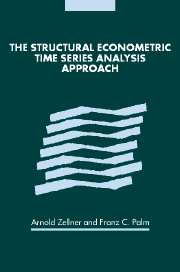Book contents
- Frontmatter
- Contents
- List of contributors
- Acknowledgments
- Introduction
- Part I The SEMTSA approach
- 1 Time series analysis and simultaneous equation econometric models (1974)
- 2 Statistical analysis of econometric models (1979)
- 3 Structural econometric modeling and time series analysis: an integrated approach (1983)
- 4 Time series analysis, forecasting, and econometric modeling: the structural econometric modeling, time series analysis (SEMTSA) approach (1994)
- 5 Large-sample estimation and testing procedures for dynamic equation systems (1980)
- Part II Selected applications
- Part III Macroeconomic forecasting and modeling
- Part IV Disaggregation, forecasting, and modeling
- Subject index
- Author index
- References
2 - Statistical analysis of econometric models (1979)
Published online by Cambridge University Press: 24 October 2009
- Frontmatter
- Contents
- List of contributors
- Acknowledgments
- Introduction
- Part I The SEMTSA approach
- 1 Time series analysis and simultaneous equation econometric models (1974)
- 2 Statistical analysis of econometric models (1979)
- 3 Structural econometric modeling and time series analysis: an integrated approach (1983)
- 4 Time series analysis, forecasting, and econometric modeling: the structural econometric modeling, time series analysis (SEMTSA) approach (1994)
- 5 Large-sample estimation and testing procedures for dynamic equation systems (1980)
- Part II Selected applications
- Part III Macroeconomic forecasting and modeling
- Part IV Disaggregation, forecasting, and modeling
- Subject index
- Author index
- References
Summary
Introduction
Substantial progress has been made in developing data, concepts, and techniques for the construction and statistical analysis of econometric models. Comprehensive data systems, including national income and product accounts, price, wage and interest rate data, monetary data, and many other measures, have been developed for almost all countries. In many cases, annual measurements have been augmented by quarterly and monthly measurements of a broad array of economic variables. In recent years, scientifically designed sample surveys have been employed to expand the data bases of a number of countries. While research continues to improve data bases, we must recognize that the work that produced our current, extensive data bases is a major accomplishment in the field of scientific measurement and enables economic analysts to avoid the charge of “theory without measurement.”
In reviewing the development of concepts for the statistical analysis of econometric models, it is very easy to forget that in the opening decades of [the twentieth] century a major issue was whether a statistical approach was appropriate for the analysis of economic phenomena. Fortunately, the recognition of the scientific value of sophisticated statistical methods in economics and business has buried this issue. To use statistics in a sophisticated way required much research on basic concepts of econometric modeling that we take for granted today. It was necessary to develop fundamental concepts such as complete model, identification, autonomous structural relationships, exogeneity, dynamic multipliers, and stochastic equilibrium, to name a few, that play an important role in linking statistical analyzes and economic theory.
- Type
- Chapter
- Information
- The Structural Econometric Time Series Analysis Approach , pp. 44 - 95Publisher: Cambridge University PressPrint publication year: 2004



